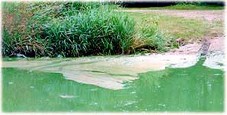I have spoken to our water quality specialist at the County. The photos that were provided - which were very helpful! Are a common duckweed. That level of surface vegetation makes it HIGHLY unlikely that any algae exists in the ponds.
That being said - two pups were extremely sick after swimming in them, which is likely due to some sort of micro-organism in the water, which we are unable to test for. Some dogs may get sick from it, others may not.
Those ponds are not very deep, and are not monitored for water quality. Which makes them subject to water quality issues. So please use them at your own risk. If you have any further questions, please let me know.
Jennifer Fink
Recreation Services Supervisor
Ramsey County
That being said - two pups were extremely sick after swimming in them, which is likely due to some sort of micro-organism in the water, which we are unable to test for. Some dogs may get sick from it, others may not.
Those ponds are not very deep, and are not monitored for water quality. Which makes them subject to water quality issues. So please use them at your own risk. If you have any further questions, please let me know.
Jennifer Fink
Recreation Services Supervisor
Ramsey County

 RSS Feed
RSS Feed
